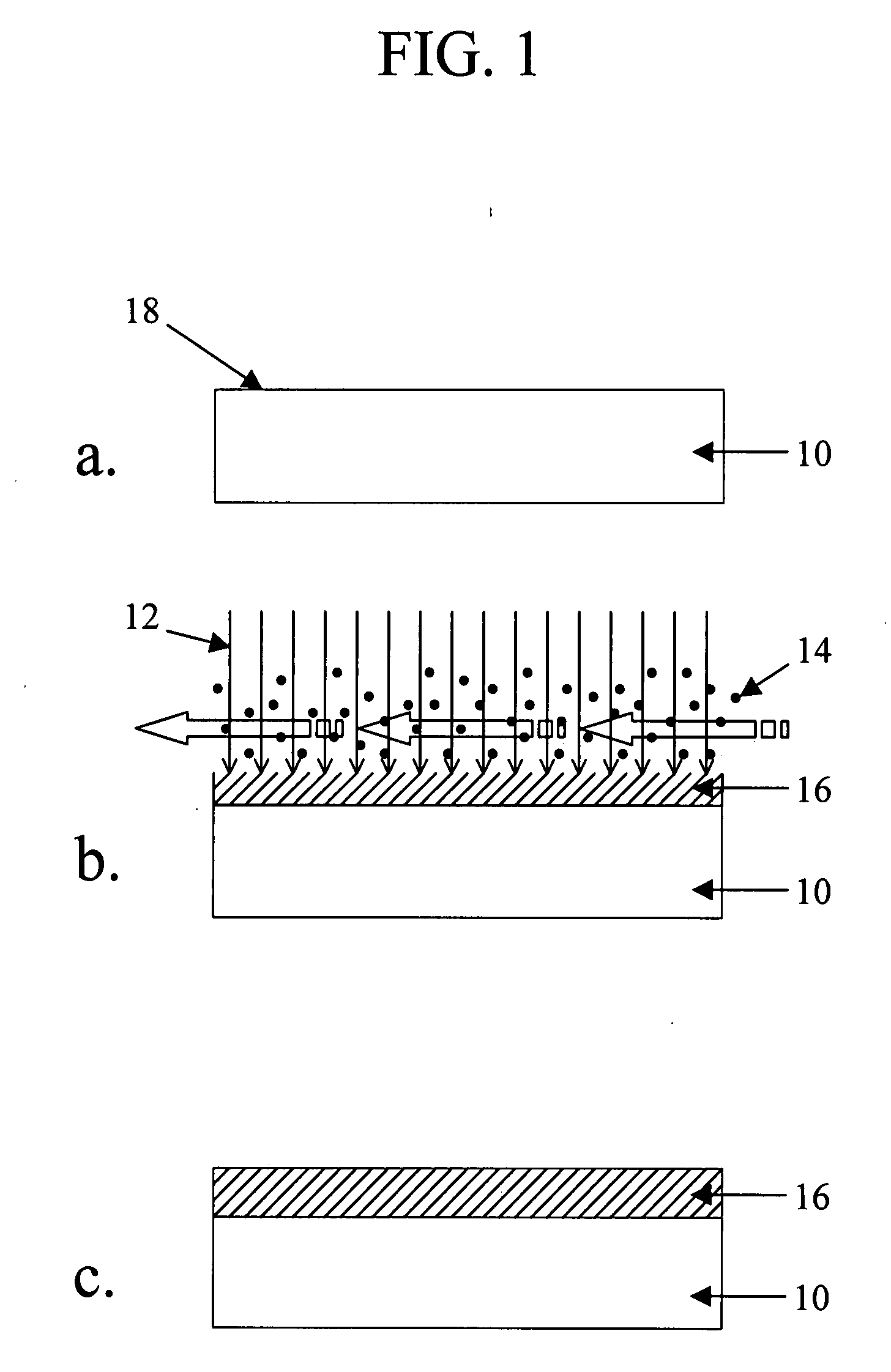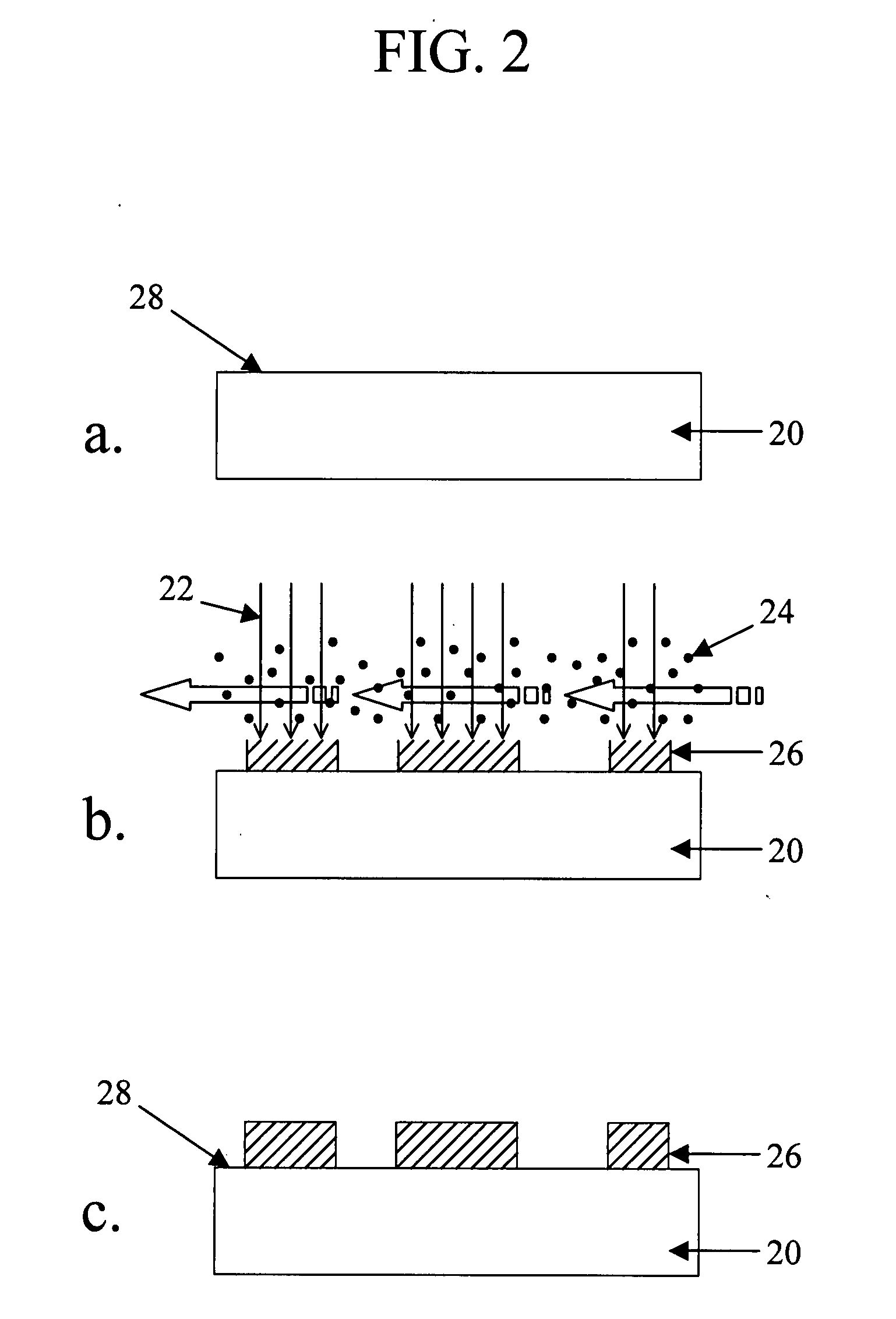Method and apparatus for laser oxidation and reduction
a laser oxidation and reduction technology, applied in the direction of electrical equipment, basic electric elements, semiconductor/solid-state device manufacturing, etc., can solve the problems of large footprint, large equipment floor space, and large particle size of equipment, and achieve high capital cost, high energy use, and significant handling
- Summary
- Abstract
- Description
- Claims
- Application Information
AI Technical Summary
Benefits of technology
Problems solved by technology
Method used
Image
Examples
experiment # 1
Experiment #1: Copper Oxidation
[0077]The purpose of the first experiment was to determine whether a 355 nm diode pumped, solid-state laser and an ozone / oxygen gas mixture could oxidize a copper substrate. The chamber pressure used was 30 Torr, with a gas flow of 2 slm and gas composition of 18.5% (by wt.) ozone in oxygen. The vacuum chuck temperature used was 90° C. The pulsed laser beam had a diameter of 417 μm and had been optically transformed into a top-hat beam. The wafer was scanned with a series of 16-interleaved scans, each with a pulse spacing of 400 μm for a final pulse spacing of 100 μm, which equates to a 76.5% overlap.
[0078]The equation to calculate the speed of the beam, which is determined mainly from the laser repetition rate and the spacing between consecutive pulses is as follows: Laser Scan Speed (in mm / s)=Laser Repetition Rate (in kHz)*Single-Scan Pulse Spacing (in μm).
[0079]The laser metrology resulting from this experiment, showing the relevant power readings, ...
experiment # 2
Experiment #2: Copper Oxidation
[0084]The purpose of the second experiment was to determine whether a Gaussian beam profile could produce a more even oxidization of a copper substrate. The chamber pressure used was 30 Torr, with a gas flow of 4 slm and gas composition of 18% (by wt.) ozone in oxygen. The vacuum chuck temperature used was 30° C., which is ambient temperature in the tool. The pulsed laser beam had a Gaussian profile with 1 / e2 diameters ranging from 688 μm to 1664 μm. The first seven sites on the wafer were scanned with a series of 16-interleaved scans, each with a pulse spacing of 400 μm for a final pulse spacing of 100 μm. The final site was scanned with a series of 64-interleaved scans, each with a pulse spacing of 400 μm, for a final pulse spacing of 50 μm.
[0085]The laser metrology resulting from this experiment, showing the relevant power readings, and dose and fluence statistics for each scanned area, along with the scanning parameters for each area, are shown in ...
experiment # 3
Experiment #3: Copper Oxidation
[0088]The purpose of the third experiment was to determine whether a rounded beam profile could produce a more even oxidization of a copper substrate. This profile has a rounded top with a steep drop-off at the edges and can be roughly defined by Equation 1 where F(r) is the intensity of the laser beam profile at a distance, r, from the center and where R is the radius of the beam.
Equation 1:Equation Defining a Rounded Beam ProfileF(r)=1-(rR)2
[0089]The chamber pressure used was 100 Torr, with a gas flow of 4 slm and gas composition of 18% (by wt.) ozone in oxygen. The vacuum chuck temperature used was 30° C. The pulsed laser beam had a rounded profile with a diameter of 1400 μm. The wafer was scanned with a series of 16-interleaved scans, each with a pulse spacing of 800 μm for a final pulse spacing of 200 μm, which equates to a 85.7% overlap. Each set of 16-scans is designated as a pass. The areas with multiple passes had the set of 16-scans run...
PUM
 Login to View More
Login to View More Abstract
Description
Claims
Application Information
 Login to View More
Login to View More - R&D
- Intellectual Property
- Life Sciences
- Materials
- Tech Scout
- Unparalleled Data Quality
- Higher Quality Content
- 60% Fewer Hallucinations
Browse by: Latest US Patents, China's latest patents, Technical Efficacy Thesaurus, Application Domain, Technology Topic, Popular Technical Reports.
© 2025 PatSnap. All rights reserved.Legal|Privacy policy|Modern Slavery Act Transparency Statement|Sitemap|About US| Contact US: help@patsnap.com



